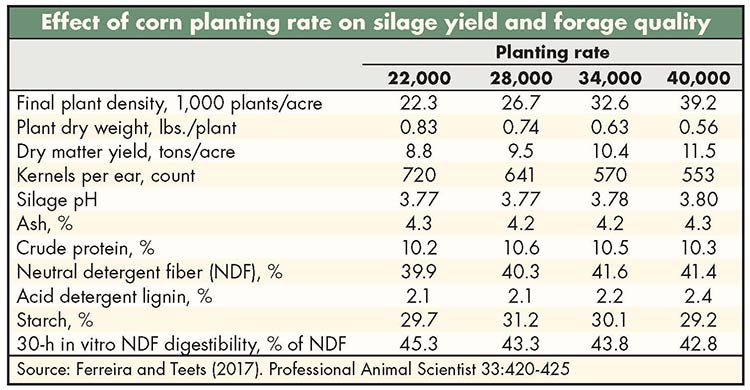The author is assistant professor, department of dairy science,Virginia Tech.
Farmers often boost corn plant densities as a means to maximize forage yields or replenish silage stocks. In the past few years, our team at Virginia Tech has performed several on-farm plant density research projects to evaluate the impact of changing plant densities on forage yield and quality.
Here are some of our results, which elicit a number of considerations when changing corn planting rates.
Forage yield
A higher corn plant density can boost forage yields (see table), although this response was not always observed in every study. The typical observation was that higher corn plant densities resulted in smaller plant weights. However, the smaller biomass per plant is often compensated by more plants per acre, resulting in similar forage yields.
There is a balance between the number of plants and the weight of the individual plants. This balance, which determines the existence of differential forage yields, is “broken” depending on maturity at harvesting. Based on observations from our studies, when a crop is harvested at early stages of maturity (namely early dent or close to 70 percent moisture), a greater number of plants cannot compensate for the smaller weight of the individual plants. Therefore, silage yield is similar.
When a crop is harvested at a more advanced maturity (half-milkline or closer to 65 percent moisture), the larger plant has more grain weight, leading to a yield advantage for higher plant densities. If the forage grower is planning an early harvest of the corn crop, then raising the population of plants to maximize forage yield might not be beneficial.

Kernel development
A higher corn plant density typically reduces the number of kernel rows per ear and the number of kernels per row within an ear.
Kernel development is a determinant of forage yield and quality, so having a reduction in the number of kernels per plant does not seem very appealing to the farmer. However, we still need to consider that there are more plants per acre at higher planting densities, which typically translates into greater yields of grain and possibly starch. Therefore, don’t base you opinion of potential silage yield and quality on the appearance of the ears.
Nutritional quality
As mentioned above, higher plant densities typically result in plants with a lower number of developed kernels per ear. Fewer developed kernels are often viewed as having reduced concentrations of starch and higher concentrations of fiber (in other words, lower energy concentrations). Contrary to this belief, several recent studies have shown that boosting corn plant density has minimum (if any) effects on the nutritional composition and the digestibility of the resulting silages.
Despite several recent studies evaluating the effect of plant density on forage yield and quality, only a few have evaluated its interaction with fertilizer management strategies. Our research team performed an on-farm study in southwest Virginia last summer (2017) where corn was planted at three densities (26,000, 30,000, or 35,000 plants or acre) with either a single (45 pounds per acre) or double (90 pounds per acre) pass of nitrogen right before elongation of the internodes. To our surprise, doubling the sidedressed nitrogen raised the forage yield by only 5 percent.
It is worth to mentioning that a very severe drought around silking time was observed during the summer in southwest Virginia. This may have masked any beneficial effects of additional nitrogen fertilization on forage yields. Despite the severe drought, the higher planting rates did not result in lower forage yields. We are still analyzing the samples for nutritional quality so stay tuned for future updates.
Cost
Planting more corn seeds per acre will raise input expenses. Whether this practice is economically viable will depend almost entirely on obtaining better forage yields. A simple partial budget and sensitivity analysis will help decide if boosting plant densities makes economic sense.
In conclusion, higher corn plant densities can improve forage yields without negatively affecting the nutritional quality of the silage. The likelihood of better forage yields is highly influenced by environmental conditions and maturity at harvest. Lower forage yields per acre due to higher plant densities are unlikely under typical growing conditions.
This article appeared in the February 2018 issue of Hay & Forage Grower on page 24.
Not a subscriber? Click to get the print magazine

